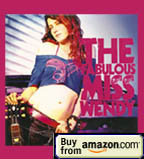|
|||||||||||||||||
November 2009 Web Edition Issue #3 |
|||||||||||||||||
|
Mondo Cult
Forum
Blog
News
Mondo Girl
Letters
Photo Galleries
Archives
Back Issues
Books
Contact Us
Features
Film
Index
Interviews
Legal
Links
Music
Staff
|
Buffalo SpringfieldBoxed SetRhino / 2001 I associate the Buffalo Springfield with Tolstoy's dictum that all great truths are simple. The Springfield's music, regardless of its degree of sophistication (not that I can tell, really), is generally as direct as a fresh headline from the AP wires without being simplistic. Part country, part folk, part hard rock, the songs tend to sport earnest lyrics, passionate, Beatlesque vocals, and frisky guitar playing. From a contemporary perspective, their music bears a vague resemblance to that of the 90s alternative rock scene, but possesses a heckuva lot more energy. The Springfield recorded between 66 and 68. They were young and wild, says Neil Young in his recent song "Buffalo Springfield Again". They had also assimilated every major musical tributary in 60s rock. Today they're remembered mostly for two things, number one being their first and only big hit single, "For What It's Worth.” a Stephen Stills composition describing the confrontation between curfew violators on the Sunset Strip and the L.A.P.D., which at the time took an antagonistic attitude toward any culturally incorrect individual. Rather than describing the incident specifically, the lyrics take a metaphorical approach. They could apply to any gathering or demonstration where a meltdown is imminent. The song remains famous today. Only a few weeks ago, I heard it on the soundtrack of a recent movie which must have a forgettable title. The number two thing is actually two, three, and four, because the Buffalo Springfield launched the career trajectories of Stills, Young, and Richie Furay, the three guitarists/singers/ songwriters. Stills went on to join Crosby, Stills & Nash (and sometimes Young), while Young has had a prolific solo career during which he has taken an unusual number of artistic risks. Furay formed Poco, had a few other bands, recorded a lot of albums, and reportedly found Jesus before dropping out of commercial sight. In 2000, a Los Angeles Times letter writer wondered if he was still in show business, the same week Furay had an upcoming club appearance listed in the Calendar section. I suppose only the people who attended the show know for sure. The boxed set celebrating the legacy of this deservedly legendary band is problematical from a listening standpoint. To say that it is repetitive is almost being redundant. The first three CDs arrange the cuts in the chronological order of their completion. Many of the songs are demos, takes of the songwriter laying down the song on an acoustic guitar. A few demos are of songs that made it to an album, while others point to subsequent albums involving Stills and/or Young. The final versions of the recordings that made it to albums are also included, the only exceptions being two missing songs from the third. The box set also contains the usual plethora of unreleased tracks and B-sides--all in chronological order, regardless of how it might affect the listening experience. As soon as the listener becomes used to the sound of a man and his guitar, he's jerked back to the full-bodied world of a working rock band, and vice versa. CD #4 (reportedly at the insistence of Young) is a two-fer containing the first two albums, plus a track that was bumped off the early pressings of the first record to make way for "For What It's Worth". This means the fan has the same songs twice--three times if its demo is included. Four times if he, as a Springfield fan, already had the albums on CD, and five times if he bought the vinyl when the albums were first released. For the sake of my sanity, I hope there is no sixth time. My point is simply that this boxed set really does support the notion that a camel is a horse that was created by a committee. The fourth CD could have been used to resurrect live performances, for instance. Anything that wasn't redundant. The saving grace, however, is the music, which rises above all such materialistic carping. High points are frequent: Furay's vocal on Young's "Do I Have to Come Right Out and Say It"; the bluegrass pickin' of "Go and Say Good-Bye"; the proto-heavy metal of Young's "Mr. Soul"; the subtle swing-influence on Stills’ "Everydays"; the heartfelt honesty of Furay's "Sad Memory" and, most portentously, Young's effort at big-time prog rock with "Broken Arrow.” Most of them, naturally, are included on CD #4, but the tracks that ultimately made it to Last Time Around show no slacking in terms of quality. The unreleased tracks include a surf instrumental extravaganza, "Kahuna Sunset" and the experimental but hard-rocking "Buffalo Stomp (Raga).” The demos, while arranged sparely, are melancholy and sincere. These guys had heart even when they thought no one else would be listening. As for the bottom line, does the Springfield Boxed Set have problems and shortcomings? You bet. Is the music fantastic? Absolutely. Is it a boxed set for die-hard fans and scholars only? Possibly, but it is never less than rewarding. My advice is to let all your friends know that your is birthday is coming, and soon. — Arthur Byron Cover | ||||||||||||||||



